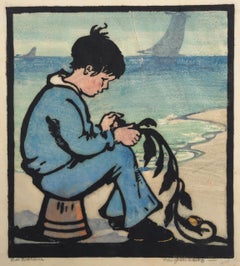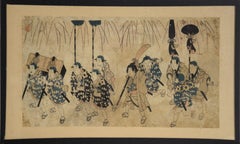Joseph Domjan Art
to
2
Overall Width
to
Overall Height
to
2
2
2
1
1
1
1
2
9,475
2,689
1,375
1,358
2
Artist: Joseph Domjan
Violets
By Joseph Domjan
Located in Surfside, FL
Born in Budapest in 1907, he had a humble upbringing and a passion for the arts. Shortly after the Hungarian Revolution broke out in 1956, Domján was invited to showcase his work in ...
Category
20th Century Joseph Domjan Art
Materials
Wood, Mixed Media, Woodcut
Bird & Young
By Joseph Domjan
Located in Surfside, FL
Born in Budapest in 1907, he had a humble upbringing and a passion for the arts. Shortly after the Hungarian Revolution broke out in 1956, Domján was invited to showcase his work in ...
Category
20th Century Joseph Domjan Art
Materials
Mixed Media, Wood Panel
Related Items
SEA TREASURES
By Frances H. Gearhart
Located in Santa Monica, CA
FRANCES H. GEARHART and Sisters (THE GEARHARTS)
SEA TREASURES...
Category
1920s American Impressionist Joseph Domjan Art
Materials
Woodcut
Festival Procession Of A Daimyo - Original Woodblock Print
Located in Soquel, CA
Procession Of A Daimyo - Original Woodblock Print
Original woodblock print depicting the procession of a Daimyo. Ten Japanese soldiers are seen as they aid in transporting the Daimy...
Category
Late 18th Century Edo Joseph Domjan Art
Materials
Ink, Wood Panel, Rice Paper
Pacific Sunset Waves, Contemporary Cyanotype on Paper, Navy Blue, Beach House
By Kind of Cyan
Located in Barcelona, ES
This is an exclusive handprinted limited edition cyanotype.
"Pacific Sunset Waves" is an original cyanotype that abstractly shows the sunset reflections on the sea.
Details:
+ Titl...
Category
2010s Realist Joseph Domjan Art
Materials
Emulsion, Mixed Media, Watercolor, Photographic Paper, Lithograph, Monop...
$312 Sale Price
20% Off
H 28 in W 40 in
DESERT BARRIER
By Frances H. Gearhart
Located in Santa Monica, CA
FRANCES H. GEARHART (1869-1958)
DESERT BARRIER c. 1933
Color block print, unsigned 12 x 9 ¼”. Typical original margins on good fibrous japan paper. Many very good impressions by G...
Category
1930s American Impressionist Joseph Domjan Art
Materials
Woodcut
16th c. woodcut map - Tabula Asiae Vlll
By Sebastian Münster
Located in Santa Monica, CA
SEBASTIAN MUNSTER (1488-1652)
ASIAE TABVLA Vlll 1540 (45)
Woodcut from Munster's edition of Geographia Universalis, Basel, Henri Petri. 1545 edit...
Category
16th Century Old Masters Joseph Domjan Art
Materials
Woodcut
$950 Sale Price
29% Off
H 9.75 in W 13.5 in
All The Things - Surfing Art - Figurative - Woodcut Print By Marc Zimmerman
By Marc Zimmerman
Located in Carmel, CA
All The Things - Surfing Art - Figurative - Woodcut Print By Marc Zimmerman
Limited Edition 01/04
This masterwork is exhibited in the Zimmerman Gallery, Carmel CA.
Immerse yoursel...
Category
2010s Contemporary Joseph Domjan Art
Materials
Woodcut
The Virtues 'Politeness', Limited Edition 'Cherry Blossom' Landscape
By Damien Hirst
Located in New York, NY
The contemporary pop art cherry blossom landscape ‘Politeness' is one of the eight from the iconic ‘Virtues’ series by Damien Hirst, the laminated giclée print on aluminum panel was ...
Category
2010s Contemporary Joseph Domjan Art
Materials
Panel, Giclée
$39,000
H 55.5 in W 45.8 in D 2 in
Jonah
By Sadao Watanabe
Located in Santa Monica, CA
SADAO WATANABE (Japanese 1913-1996)
JONAH, 1959
Color stencil, signed, numbered and dated in white ink. Sheet, 25 5/8 x 22 5/8 inches. Edition: 44/50. Good color and generally good ...
Category
1950s Modern Joseph Domjan Art
Materials
Woodcut, Stencil
Huge - CASTLE ROCK WYOMING (Jackson Hole),
By Werner Drewes
Located in Santa Monica, CA
WERNER DREWES (1899 - 1985)
CASTLE ROCK WYOMING (Jackson Hole), (Rose RIII 194)
Color woodcut Total edition XXX, Signed, annotated AP and dated '58 in...
Category
1950s Abstract Expressionist Joseph Domjan Art
Materials
Woodcut
FISH MARKET
By Frances H. Gearhart
Located in Santa Monica, CA
FRANCES H. GEARHART (1869 – 1958)
FISH MARKET 1930
Color block print, Signed and titled in pencil. Image 11 x 9 inches. Full sheet with deckle edges 14 3/...
Category
1930s Joseph Domjan Art
Materials
Woodcut
EARLY JACOULET - A DOWNPOUR AT METALANIM PONOPE EAST CAROLINAS
By Paul Jacoulet
Located in Santa Monica, CA
EARLY JACOULET
PAUL JACOULET (1896 – 1960)
UNE AVERSEA METALANIM, PONAPE , EST CAROLINES, 1935
A DOWNPOUR AT METALANIM PONOPE EAT CAROLINAS (Miles 29)
Color woodcut, with metallic ...
Category
1930s Modern Joseph Domjan Art
Materials
Color, Woodcut
$1,500
H 15.5 in W 11.75 in
Galactic Man, Peter Max
By Peter Max
Located in Fairfield, CT
Artist: Peter Max (1937)
Title: Galactic Man
Year: 1982
Medium: Unique, mixed media with lithography and hand coloring on Arches paper
Size: 6.75 x 6.25 inches
Condition: Excellent
I...
Category
1980s Pop Art Joseph Domjan Art
Materials
Mixed Media, Lithograph
Previously Available Items
Violets
By Joseph Domjan
Located in Surfside, FL
Born in Budapest in 1907, he had a humble upbringing and a passion for the arts. Shortly after the Hungarian Revolution broke out in 1956, Domján was invited to showcase his work in New York; given both the circumstances and opportunities, he readily accepted. Eventually, with his wife and children, he settled in Tuxedo Park. Here, he established the Domján Studio and where lived until his passing in 1992. In his early years, and during the Great Depression, Domján toured Europe with the desire to be engulfed by art. Previously, much of his time had been consumed with the work of both an engine fitter and foundry worker. After testing the waters of over 20 different professions, he discovered his passion in the arts. Later, during his European tour, he earned his way by selling a variety of works including both paintings and sketches. Post-depression, he returned to Hungry where he studied seven years at the Budapest Academy of Arts.
Having spent an earlier portion of his life as a painter, Domján created his first woodcut in 1947 by using oil paint as opposed to printer’s ink. The result was stunning. This technique, becoming his signature style, would later set him apart from others within the trade. To create his pieces, Domján applied rich color, layer by layer, and lays claim to having “succeeded in bringing to the world something that had not existed before.”
Ultimately, each print became three dimensional and gave the appearance of a painting. His technique has gained him international merit as well as the honor of receiving China’s “Master of the Color Wooodcut” award, a recognition given only once every century. The inspiration behind many of Domján’s woodcuts, coupled with his love of nature, is derived from Hungary’s brilliant folklore. The intricacy of his design is certainly his prominent element; however, their subtle coloring and abstract images contribute to his
unique style.
For the 59th Anniversary of composer Béla Bartók’s opera, Duke Bluebeard’s Castle, Domján used the opera’s profound imagery to create a series of woodcuts. The work included an ominous castle, coiled snakes, smirking masks, elusive zodiac symbols, and the story’s forbidden key. In doing so, Domján was able to weave traditional folklore components into a fantastic piece of modernized art. His work is not only expressive of Hungarian folklore...
Category
20th Century Joseph Domjan Art
Materials
Wood, Mixed Media, Woodcut
Bird & Young
By Joseph Domjan
Located in Surfside, FL
Born in Budapest in 1907, he had a humble upbringing and a passion for the arts. Shortly after the Hungarian Revolution broke out in 1956, Domján was invited to showcase his work in New York; given both the circumstances and opportunities, he readily accepted. Eventually, with his wife and children, he settled in Tuxedo Park. Here, he established the Domján Studio and where lived until his passing in 1992. In his early years, and during the Great Depression, Domján toured Europe with the desire to be engulfed by art. Previously, much of his time had been consumed with the work of both an engine fitter and foundry worker. After testing the waters of over 20 different professions, he discovered his passion in the arts. Later, during his European tour, he earned his way by selling a variety of works including both paintings and sketches. Post-depression, he returned to Hungry where he studied seven years at the Budapest Academy of Arts.
Having spent an earlier portion of his life as a painter, Domján created his first woodcut in 1947 by using oil paint as opposed to printer’s ink. The result was stunning. This technique, becoming his signature style, would later set him apart from others within the trade. To create his pieces, Domján applied rich color, layer by layer, and lays claim to having “succeeded in bringing to the world something that had not existed before.”
Ultimately, each print became three dimensional and gave the appearance of a painting. His technique has gained him international merit as well as the honor of receiving China’s “Master of the Color Wooodcut” award, a recognition given only once every century. The inspiration behind many of Domján’s woodcuts, coupled with his love of nature, is derived from Hungary’s brilliant folklore. The intricacy of his design is certainly his prominent element; however, their subtle coloring and abstract images contribute to his
unique style.
For the 59th Anniversary of composer Béla Bartók’s opera, Duke Bluebeard’s Castle, Domján used the opera’s profound imagery to create a series of woodcuts. The work included an ominous castle, coiled snakes, smirking masks, elusive zodiac symbols, and the story’s forbidden key. In doing so, Domján was able to weave traditional folklore components into a fantastic piece of modernized art. His work is not only expressive of Hungarian folklore...
Category
20th Century Joseph Domjan Art
Materials
Mixed Media, Wood Panel
Violets
By Joseph Domjan
Located in Surfside, FL
Born in Budapest in 1907, he had a humble upbringing and a passion for the arts. Shortly after the Hungarian Revolution broke out in 1956, Domján was invited to showcase his work in...
Category
20th Century Joseph Domjan Art
Materials
Mixed Media, Wood, Woodcut
Bird & Young
By Joseph Domjan
Located in Surfside, FL
Born in Budapest in 1907, he had a humble upbringing and a passion for the arts. Shortly after the Hungarian Revolution broke out in 1956, Domján was invited to showcase his work in...
Category
20th Century Joseph Domjan Art
Materials
Mixed Media, Wood Panel
Joseph Domjan art for sale on 1stDibs.
Find a wide variety of authentic Joseph Domjan art available for sale on 1stDibs. You can also browse by medium to find art by Joseph Domjan in mixed media, panel, wood panel and more. Not every interior allows for large Joseph Domjan art, so small editions measuring 17 inches across are available. Customers who are interested in this artist might also find the work of Marcel Vertès, Jozsef Jakovits, and François Fiedler. Joseph Domjan art prices can differ depending upon medium, time period and other attributes. On 1stDibs, the price for these items starts at $1,200 and tops out at $1,200, while the average work can sell for $1,200.

